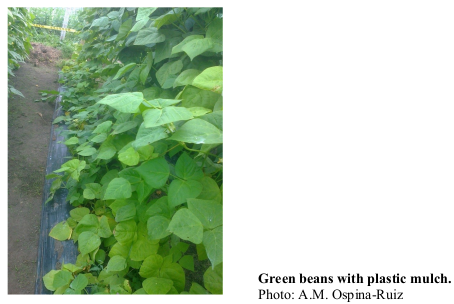Technical and economic study of commercial varieties of green beans with plastic mulch

Abstract
Green beans are consumed worldwide due to their healthy nutritional properties. These are an important part of the modern “Grab-and-Go” diet, along with the traditional diet. Green beans are rich in protein, vitamins, fiber, folic acid and numerous minerals. In Colombia, the production of green beans is concentrated in the eastern mountain range, where there are currently low yields due to the phytosanitary problems associated with the traditional Blue Lake variety, added to the little implementation of production strategies such as plastic mulches. Thus, four varieties of green beans with plastic mulch were technically and economically evaluated. The experimental design used was complete randomized blocks with eight treatments, resulted of factors combination of the varieties (UNAPAL Milenio, Blue Lake Pole, Blue Lake National and Blue Lake S-7) and with and without plastic mulch, with four repetitions and an experimental unit of 25 plants. Planting distances were 0.25 m between plants and 1.2 m between rows for a population density of 33,333 plants/ha. The variables evaluated were: yield components, production per plant (g) and crop yield (t ha-1). The plastic mulch (black-black) had no differential effect on the agronomic behavior of the green bean varieties in the study area. The UNAPAL Milenio variety, with 9,134 kg ha-1, reached an agronomic behavior similar to the conventional Blue Lake variety with 9,717 kg ha-1. The Blue Lake variety presented the best economic behavior with a cost-benefit ratio of 1.15 and a rate of return of 14.85%.
Keywords
Phaseolus vulgaris L., Plasticulture, Productivity, Profitability, Yield components
Author Biography
Alejandro Hurtado-Salazar
Departamento de Produccion Agropecuaria
References
- Agronet. 2023. Cifras Agropecuarias. In: https://www.agronet.gov.co/estadistica/Paginas/home.aspx?cod=1; consulted: January, 2023.
- Arbeláez, L., J. Rivera, A. Hurtado-Salazar, and N. Ceballos-Aguirre. 2016. Technical and economic evaluation of three types of tomato nutrient solutions under semi-controlled conditions. J. Agric. Sci. 8(8), 68-78. Doi: https://doi.org/10.5539/jas.v8n8p68
- Blair, M.W., A. Chaves, A. Tofiño, J.F. Calderón, and J.D. Palacio. 2010. Extensive diversity and inter-genepool introgression in a world-wide collection of indeterminate snap bean accessions. Theor. Appl. Genet. 120, 1381-1391. Doi: https://doi.org/10.1007/s00122-010-1262-4
- Calero, A., Y. Pérez, Y. González-Pardo, L.A. Yanes, K. Peña, D. Olivera, and J.F. Meléndrez. 2020. Respuesta agroproductiva de la habichuela a la aplicación de vermicompost lixiviado y microorganismos eficientes. Rev. Fac. Cienc. 9(1), 112-124. Doi: https://doi.org/10.15446/rev.fac.cienc.v9n1.82584
- Cenicafé, Centro Nacional de Investigaciones de Café Colombia. 2022. Anuario meteorológico cafetero 2021. Chinchina, Colombia. Doi: https://doi.org/10.38141/10782/anu2021
- Colombia DANE, Departamento Nacional de Estadística. 2013. Encuesta Nacional Agropecuaria - ENA - 2013 - I - Semestre. In: http://microdatos.dane.gov.co/index.php/catalog/677; consulted: February, 2023.
- Colombia DANE, Departamento Nacional de Estadística. 2016. Cultivo de la habichuela (Phaseolus vulgaris L.) y el fenómeno de El Niño. Boletín Mensual No. 43: insumos y factores asociados a la producción agropecuaria. Bogota.
- Colombia DANE, Departamento Administrativo Nacional de Estadística. 2023. Sistema de Información de Precios y Abastecimiento del Sector Agropecuarios (SIPSA)-Componente precios mayoristas diario. 2022. In: https://www.dane.gov.co/index.php/estadisticas-por-tema/agropecuario/sistema-de-informacion-de-precios-sipsa/componente-precios-mayoristas; consulted: January, 2023.
- Fischer, G., J.A. Cleves-Leguizamo, and H.E. Balaguera-López. 2022. Impact of soil temperature on fruit species within climate change scenarios. Rev. Colomb. Cienc. Hortic. 16(1), e12769. Doi: https://doi.org/10.19053/rcch.2022v16i1.12769
- Gao, H., C. Yan, Q. Liu, W. Ding, B. Chen, and Z. Li. 2019. Effects of plastic mulching and plastic residue on agricultural production: A meta-analysis. Sci. Total Environ. 651(Part 1), 484-492. Doi: https://doi.org/10.1016/j.scitotenv.2018.09.105
- Hernández, L., N. Hernández, F. Soto, and M.A. Pino. 2010. Estudio fenológico preliminar de seis cultivares de habichuela de la especie Phaseolus vulgaris L. Cul. Trop. 31(1), 54-61.
- Herrera, H.J., A. Hurtado-Salazar, and N. Ceballos-Aguirre. 2015. Estudio técnico y económico del tomate tipo cereza élite (Solanum lycopersicum L. var. cerasiforme) bajo condiciones semicontroladas. Rev. Colomb. Cienc. Hortic. 9(2), 290-300. Doi: https://doi.org/10.17584/rcch.2015v9i2.4185
- Kabir, H., M. Musharraf, M.M. Haque, and M. Khan. 2015. Technical efficiency of boro rice production in Bangladesh: A case of bio-slurry application. J. Bangladesh Agric. Univ. 13(1), 101-108. Doi: https://doi.org/10.3329/jbau.v13i1.28725
- Martínez-Reina, A., L. Tordecilla-Zumaqué, C. Cordero-Cordero, and L. Grandett-Martínez. 2019. Entorno tecnológico y socioeconómico de la habichuela larga en el Caribe Húmedo de Colombia. Cienc. Agric. 16(2), 7-24. Doi: https://doi.org/10.19053/01228420.v16.n2.2019.9114
- Obando, F.H., A.M. Villegas, J.H. Betancur, and L. Echeverri. 2006. Variabilidad espacial de propiedades químicas y físicas en un Typic Udivitrands, arenoso de la región andina central colombiana. Rev. Fac. Nac. Agron. Medellin 59(1), 3217-3235.
- Petropoulos, S.A., A. Fernandes, S. Plexida, A. Chrysargyris, N. Tzortzakis, J.C.M. Barreira, L. Barros, and I.C.F.R. Ferreira. 2020. Biostimulants application alleviates water stress effects on yield and chemical composition of greenhouse green bean (Phaseolus vulgaris L.). Agronomy 10(2), 181. Doi: https://doi.org/10.3390/agronomy10020181
- PQA. 2023. Productos y servicios, In: Productos químicos andinos, https://www.pqapag.co/; consulted: February, 2023.
- San-Miguel, J., C.A. Montoya, I. Lores, C.J. Arreola, and J. Vera. 2021. Respuesta productiva de la habichuela (Vigna unguiculata Sub sp sesquipedalis) al efecto de Mudra Extra®. Hombre, Ciencia y Tecnología 25(4) 1-8.
- Tofanelli, M.B.D. and S.E. Wortman. 2020. Benchmarking the agronomic performance of biodegradable mulches against polyethylene mulch film: A meta-analysis. Agronomy 10(10), 1618. Doi: https://doi.org/10.3390/agronomy10101618
- Vallejo, F. and E. Estrada. 2004. El cultivo de la habichuela. pp. 269-290. En: Vallejo, F. and E. Estrada (eds.). Producción de hortalizas de clima cálido. Universidad Nacional de Colombia, Palmira, Colombia.
- Villota, M.A., L.E. Saavedra, and S.H. de Cantillo. 1993. Eficiencia de la fertilización convencional frente a la fertilización completa en habichuela, Phaseolus vulgaris L., en un suelo de Pradera, Valle del Cauca. Acta Agron. 43(1-4), 121-133.
- Zribi, W., J.M. Faci, and R. Aragüés. 2011. Efectos del acolchado sobre la humedad, temperatura, estructura y salinidad de suelos agrícolas. Inf. Téc. Econ. Agrar. 107(2), 148-162.
